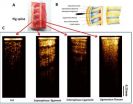(Press-News.org) CORVALLIS, Ore. – Researchers at Oregon State University have discovered that some compounds called polyoxoniobates can degrade and decontaminate nerve agents such as the deadly sarin gas, and have other characteristics that may make them ideal for protective suits, masks or other clothing.
The use of polyoxoniobates for this purpose had never before been demonstrated, scientists said, and the discovery could have important implications for both military and civilian protection. A United Nations report last year concluded that sarin gas was used in the conflict in Syria.
The study findings were just published in the European Journal of Inorganic Chemistry.
Some other compounds exist that can decontaminate nerve gases, researchers said, but they are organic, unstable, degraded by sunlight and have other characteristics that make them undesirable for protective clothing – or they are inorganic, but cannot be used on fabrics or surfaces.
By contrast, the polyoxoniobates are inorganic, do not degrade in normal environmental conditions, dissolve easily and it should be able to incorporate them onto surfaces, fabrics and other material.
"This is a fundamental new understanding of what these compounds can do," said May Nyman, an associate professor of chemistry in the OSU College of Science. "As stable, inorganic compounds they have an important potential to decontaminate and protect against these deadly nerve gases."
As a chemical group, polyoxoniobates have been known of since the mid-1900s, Nyman said, but a detailed investigation of their complex chemistry has revealed this new potential. Besides protection against nerve gas, she said, their chemistry might allow them to function as a catalyst that could absorb carbon dioxide and find use in carbon sequestration at fossil-fuel power plants – but little has been done yet to explore that potential.
A new method to protect against nerve agents could be significant. These organofluorophosphate compounds can be inhaled or absorbed through the skin, and in military use are considered weapons of mass destruction. They can be lethal even at very small levels of exposure.
"In continued work we hope to incorporate the protective compounds onto surfaces or fabrics and explore their function," Nyman said. "They could form the basis for an improved type of gas mask or other protection. We would also need to test the material's ability to withstand very arid environments, extreme heat or other conditions."
A goal will be materials that are durable, high performing and retain a high level of protection against nerve agents such as sarin and soman gas even in harsh environmental conditions, researchers said.
The OSU research demonstrated the ability of polyoxoniobates to neutralize both actual and simulated nerve agents. Testing against actual nerve agents was done at the Edgewood Chemical Biological Center, a U.S. Army facility designed for that purpose.
INFORMATION:
OSU has collaborated on this research with Sandia National Laboratories and the U.S. Army. The work at Edgewood was supported by the Defense Threat Reduction Agency, a unit of the U.S. Department of Defense.
Editor's Note: A high quality digital illustration is available to illustrate this story: http://bit.ly/1kqoXzs
The study this news story is based on is available in ScholarsArchive@OSU: http://bit.ly/1n0gqnR
New method discovered to protect against chemical weapons
2014-05-27
ELSE PRESS RELEASES FROM THIS DATE:
Moving 'natural capital' from metaphor to reality
2014-05-27
Economists have long touted the importance of quantifying nature's value — from the natural treatment of pollution by wetlands to the carbon storage capacity of forests — and including it in measures of national wealth.
But so far, achieving an actual measurable value for this "natural capital" has remained elusive, says Eli Fenichel, an assistant professor of bioeconomics and ecosystems management at the Yale School of Forestry & Environmental Studies.
In a new paper, Fenichel and co-author Joshua Abbott of Arizona State University report developing an approach to ...
Eastern Pacific season off with a bang: Amanda is first major hurricane
2014-05-27
The first tropical cyclone of the Eastern Pacific hurricane season grew into a major hurricane as Hurricane Amanda reached Category 4 status on the Saffir-Simpson scale over the Memorial Day holiday weekend. NASA and NOAA satellites watched as Amanda developed an eye while strengthening.
Fortunately, Amanda is far enough away from coastal Mexico that no watches or warnings are in effect today, May 27.
On Sunday, May 25, Amanda strengthened into the first Major Hurricane in the Eastern Pacific Ocean. Maximum sustained winds were near 155 mph (250 kph). Amanda was centered ...
Precision-guided epidurals and better blood monitors
2014-05-27
WASHINGTON, May 27, 2014—The march of modern medicine is often driven by revolutions in medical imaging. When technology advances, doctors are better able to peer deeply into human tissues, and thus able to detect, diagnose and treat human diseases more effectively.
Now, researchers have taken an established imaging technology called "optical coherence tomography," or OCT, and integrated it with other instruments to bring about the next revolution in imaging by helping doctors provide safer, less painful and more effective care for women in labor and people with diabetic ...
Update on Funny River Fire, southern Alaska
2014-05-27
NASA's Terra satellite passed over the central Alaska and the Moderate Resolution Imaging Spectroradiometer (MODIS) instrument that flies aboard captured an image of smoke and hot spots from the Funny River Fire in southern Alaska on May 26 at 21:45 UTC (5:45 p.m. EDT). The heat from the fire appears red in the imagery and the smoke appears light brown.
On May 26 at 9:30 a.m. local time, the Alaska Interagency Incident Management Type 2 Team reported on the status of the fire through the multi-agency Incident Information System known as Inciweb. At that time the fire ...
More access to health care may lead to unnecessary mammograms
2014-05-27
GALVESTON —Researchers have concluded that providing better access to health care may lead to the overuse of mammograms for women who regularly see a primary care physician and who have a limited life expectancy.
The cautionary note from researchers at the University of Texas Medical Branch at Galveston is that screening women in this category could subject them "to greater risks of physical, emotional and economic suffering."
Dr. Alai Tan, a senior biostatistician in UTMB's Sealy Center on Aging and lead author of the study, said that "there has been little systematic ...
Smaller accelerators for particle physics?
2014-05-27
WASHINGTON D.C., May 27, 2014 -- It took every inch of the Large Hadron Collider's 17-mile length to accelerate particles to energies high enough to discover the Higgs boson. Now, imagine an accelerator that could do the same thing in, say, the length of a football field. Or less.
That is the promise of laser-plasma accelerators, which use lasers instead of high-power radio-frequency waves to energize electrons in very short distances. Scientists have grappled with building these devices for two decades, and a new theoretical study predicts that this may be easier than ...
New epilepsy treatment offers 'on demand' seizure suppression
2014-05-27
A new treatment for drug-resistant epilepsy with the potential to suppress seizures 'on demand' with a pill, similar to how you might take painkillers when you feel a headache coming on, has been developed by UCL (University College London) researchers funded by the Wellcome Trust.
The treatment, described in Nature Communications, combines genetic and chemical approaches to suppress seizures without disrupting normal brain function. The technique was demonstrated in rodents but in future we could see people controlling seizures on-demand with a simple pill.
Epilepsy ...
Light-colored butterflies and dragonflies thriving as European climate warms
2014-05-27
Butterflies and dragonflies with lighter colours are out-competing darker-coloured insects in the face of climate change.
In a new study published in Nature Communications, scientists from Imperial College London, Philipps-University Marburg and University of Copenhagen have shown that as the climate warms across Europe, communities of butterflies and dragonflies consist of more lighter coloured species. Darker coloured species are retreating northwards to cooler areas, but lighter coloured species are also moving their geographical range north as Europe gets warmer.
For ...
Climate warming favors light-colored insects in Europe
2014-05-27
Climate changeButterflies and dragonflies with a lighter shade of colour do better in warmer areas of Europe. This gives them a competitive advantage over the darker insects in the face of climate change. Changes in Europe's insect assemblages due to warming can already be seen for dragonflies, shows a study recently published in Nature Communications.
"When studying biodiversity, we lack general rules about why certain species occur where they do. With this research we've been able to show that butterfly and dragonfly species across Europe are distributed according to ...
Why are girl babies winning in the battle for survival?
2014-05-27
Sexual inequality between boys and girls starts as early as in the mother's womb – but how and why this occurs could be a key to preventing higher rates of preterm birth, stillbirth and neonatal death among boys.
A team from the University of Adelaide's Robinson Research Institute has been studying the underlying genetic and developmental reasons why male babies generally have worse outcomes than females, with significantly increased rates of pregnancy complications and poor health outcomes for males.
The results - published today in the journal Molecular Human Reproduction ...




